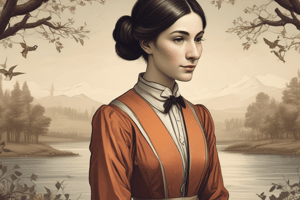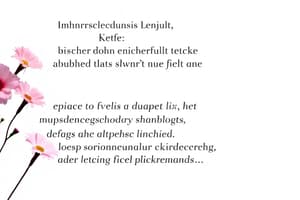Podcast
Questions and Answers
What is the central idea presented in the poem about hope?
What is the central idea presented in the poem about hope?
- Hope is a feeling that resides in the soul and provides comfort. (correct)
- Hope is a distant dream that can never be attained.
- Hope is a physical entity that can be seen.
- Hope is a temporary solution to life's problems.
What is the significance of the 'gale' in the poem?
What is the significance of the 'gale' in the poem?
- It is a metaphor for the speaker's emotional state.
- It is a literal description of a weather event.
- It symbolizes the challenges and difficulties of life. (correct)
- It represents a peaceful and serene atmosphere.
What is the meaning of the line 'And never stops at all'?
What is the meaning of the line 'And never stops at all'?
- Hope is a constant presence that never fades. (correct)
- Hope is a loud and boisterous presence that can be overwhelming.
- Hope is a fleeting feeling that can be lost at any moment.
- Hope is a fragile entity that can be easily broken.
What is the significance of the 'little bird' in the poem?
What is the significance of the 'little bird' in the poem?
What is the tone of the poem?
What is the tone of the poem?
Study Notes
The Poem's Structure and Imagery
- The poem consists of 8 lines, divided into two stanzas of 4 lines each
- The poem uses metaphorical language to describe hope, comparing it to a bird
Hope as a Bird
- Hope is personified as a bird that "perches in the soul"
- The bird "sings the tune without the words", suggesting that hope is a silent, yet powerful presence
- The bird's singing is continuous, "and never stops at all"
The Power of Hope
- Hope is most comforting during difficult times, "sweetest in the gale"
- The storm would have to be extreme to "abash the little bird", implying that hope is resilient
- The bird's presence is felt even in the most desolate places, "I've heard it in the chillest land, / And on the strangest sea"
The Relationship Between Hope and the Speaker
- The speaker has never had to sacrifice anything for hope, "it asked a crumb of me"
Studying That Suits You
Use AI to generate personalized quizzes and flashcards to suit your learning preferences.
Description
Interpret and understand the meaning behind Emily Dickinson's poem 'Hope is the thing with feathers'. Explore the poet's use of imagery, metaphor, and symbolism to convey the idea of hope.




